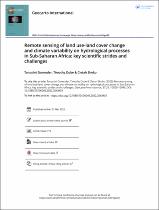| dc.contributor.author | Govender, Tanushri | |
| dc.contributor.author | Dube, Timothy | |
| dc.contributor.author | Shoko, Cletah | |
| dc.date.accessioned | 2023-06-15T12:16:44Z | |
| dc.date.available | 2023-06-15T12:16:44Z | |
| dc.date.issued | 2022 | |
| dc.identifier.citation | Govender, T. et al. (2022). Remote sensing of land use-land cover change and climate variability on hydrological processes in Sub-Saharan Africa: Key scientific strides and challenges. Geocarto International, 37(25),10925–10949. https://doi.org/10.1080/10106049.2022.2043451 | en_US |
| dc.identifier.issn | 1752-0762 | |
| dc.identifier.uri | https://doi.org/10.1080/10106049.2022.2043451 | |
| dc.identifier.uri | http://hdl.handle.net/10566/9100 | |
| dc.description.abstract | The impact of land use land cover (LULC) change and climatevariability on water resources poses as a major threat in semi-aridenvironments, especially in the sub-Saharan Africa. Countries insub-Saharan Africa are vulnerable to water scarcity. Hence, thereis an urgent need for understanding the various methods forLULC change and climate variability assessment, to aid in waterresources management at various scales. Various studies havemodelled and assessed the effect of LULC change and climatevariability on hydrological responses, using different approaches.In this regard, this paper provides a detailed review on the pro-gress of various remote sensing techniques in modelling andassessing the effect of LULC change and climate variability onhydrological processes. | en_US |
| dc.language.iso | en | en_US |
| dc.publisher | Taylor and Francis Group | en_US |
| dc.subject | Climate change | en_US |
| dc.subject | Remote sensing | en_US |
| dc.subject | Technology | en_US |
| dc.subject | Sub-Sahara Africa | en_US |
| dc.subject | Water resources | en_US |
| dc.title | Remote sensing of land use-land cover change and climate variability on hydrological processes in Sub-Saharan Africa: Key scientific strides and challenges | en_US |
| dc.type | Article | en_US |

